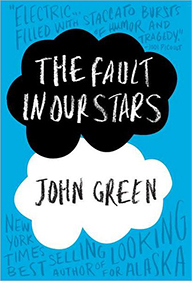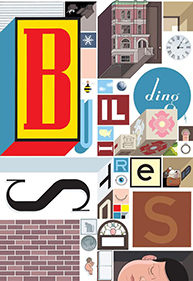by David Abrams
Buy on NOOK »-
March 27, 2013
Zombie Round
-
John Green
Z1The Fault in Our Stars
v.
4Building StoriesChris Ware
-
Judged by
Natasha Vargas-Cooper
My main problem with these books is their inherent juvenilia—one is a comic book, the other is designed for children.
Left to my own grown-up devices, I will always choose a novel that has a more adult sensibility. What is an adult sensibility, you ask? Like pornography, you’ll know it when you see it. So much of our culture has already been ceded to the grubby hands and blunted tastes of teenagers, I refuse to surrender my reading choices to them as well. Those sext-addicted little monsters already seized the movies from us—The Avengers is a stupid movie, and shame on if you are old enough to menstruate and think otherwise—must we also concede literature?
Now, you might think given my extreme and righteous prejudice against humans born in the ’90s, I’d axe John Green’s The Fault in Our Stars on principle, thus striking a symbolic (but courageous) blow against the ravenous youth cult. In fact, I didn’t know The Fault in Our Stars was for young adults. I thought it was for adult adults! I had never heard of John Green, and felt a little betrayed when I discovered his rock-star status among the philis-teen horde.
You could also suspect that I’d champion Chris Ware’s Building Stories because it features such adult content as abortion! Anal sex! Dying alone! Melancholic drawings of a one-legged woman with plump breasts floating anxiously in a bathtub!
But let us talk about the Ware’s problems first.
Building Stories has many difficulties, but mainly it’s not an actual book so much as a twee art project. I just finished Karl Schögel’s Moscow 1937, a dense and literary account of the Great Terror, and a line from Benjamin Schwarz’s review of Moscow 1937 kept echoing in my head as I scanned the panels of Ware’s Stories: “[Moscow 1937] testifies to the enduring value and purpose of that perhaps now-vanishing triumph of the human intellect, the book.”
I found no great literary triumph in Ware’s art project. Perhaps I’m too much of a traditionalist, but I’m deeply uninterested in arguments trumpeting the merits of its “visual language” or “storytelling innovation,” or the “experience” of unfolding a 50-dollar packet of fragile flip books and delicate pamphlets. I found this arrangement precious and cumbersome. Did this creative but flimsy (dis)organization of the “book” improve its narrative? No, it did not.
I read books for language. For me, language is invigorating. I read to see how different words vibrate next to each other. I read to steal adjectives. I search for sentences that give voice to the inexplicable feelings that course through my body. I read serious books because I am old enough to know what all the words mean. And Building Stories’s fundamental flaw is its lack of language.
You can’t accuse me of not “getting” graphic novels, either. I grew up glued to the Vertigo catalogue. I dressed up as the character Death from Neil Gaimain’s Sandman series several Halloweens in a row. I find there to be some excellent writing in the Preacher series. So I like graphic novels, but I think I would have enjoyed Building Stories more if I were still in my teens because the whole thing strikes me as affected (there’s a talking building in the book). Especially since its elaborate packaging allows the thing to double as an oversized merit badge of taste and sensitivity to be displayed on the coffee tables of the McSweeney’s set.
Nevertheless, Building Stories has several understated but emotionally resonant images. I could describe them to you but that would be cheating them out of their purpose, which is to eschew language in favor of visuals.
And now let us talk about the Green for a moment, in particular the positives.
Green, whose novel contains language and then some. Indeed, the critique I’ve most often read about The Fault in Our Stars is that his cancer-stricken high school students are too adult in their language, too sophisticated in their dialogue. To hell with all that, I say! Bring on the verbose teens. Here comes 17-year-old Hazel at a cancer support group discussing the eroding nature of time:
There will come a time when there are no human beings remaining to remember that any one ever existed or that our species ever did anything. There will be no one left to remember Aristotle or Cleopatra, let alone you…There was a time before organisms experienced consciousness, and there will be time after. And if the inevitability of human oblivion worries you, I encourage you to ignore it. God knows that’s what everyone else does.
The excerpt above is Hazel paraphrasing an existentialist novelist she idolizes. Eventually she and her love interest, the florid but sincere Augustus Waters, travel to Amsterdam to meet the reclusive author. Hazel sits between her mother and Augustus on the protracted plane ride over the Atlantic. In the dead of night, Augustus places his head on Hazel’s shoulder and asks her to read or recite a poem. She chooses T.S. Eliot’s “The Love Song of J. Alfred Prufrock.”
Let us go then, you and I,
When the evening is spread out against the sky
Like a patient etherized upon a table;
This is a poem I have read hundreds of times. I still remember the first time I read its verses printed on the rice paper of the Norton Anthology of Literature in my junior year of college. I remember the way my finger traced under the mischievous question: “Do I dare to eat a peach?” I was one year older than Hazel at the time. Reading the poem again, reprinted in the pages of Green’s novel, over a decade older, I still marvel at the way the words jostle and play, and how their meaning has shifted over time.
I admire Green’s unfussy exuberance for knowledge. The Fault in Our Stars, which gets its name from Shakespeare’s Julius Caesar, is bursting with all the tingling tidbits of a basic humanities education: scraps from poetry, plays, history, myths, and psychology. It all reminded me of what Orwell said about Shakespeare, “Even the irrelevancies that litter every one of his plays—the puns and riddles, the lists of names, the scraps of “reportage” like the conversation of the carriers in Henry IV, the bawdy jokes, the rescued fragments of forgotten ballads—are merely the products of excessive vitality.”
None of what Green references is doctoral-level stuff, it’s all very college freshman year, but it captures joys in those clumsy first gropes at adulthood when you are exposed to Sylvia Plath, Maslow’s Hierarchy of Needs, Greek philosophy, Shakespeare’s sonnets, when it feels as though the whole surface of the Earth is rushing up to you at once.
So perhaps you did see this coming, but I choose the Stars.
I’d like to add that, as much as I enjoyed The Fault in Our Stars, out of tribal allegiances to those who are old enough to rent cars, I would not be at all disappointed if, in some other parallel Tournament universe, it was crushed under the boot heel of a more adult tract about, say, the assassination of Nazi leader Reinhard Heydrich in Prague during World War II! Go, HHhH!
Match Commentary
By Kevin Guilfoile & John Warner
Kevin: Um, John?
John: …
Kevin: Sigh. OK, I’ll go.
In the early days of the Rooster, if one of the judges said something particularly condescending or dismissive about one of the novels in competition, you and I would unload on him or her like Iron Man and Thor on Loki after Loki accidentally freed Molto the Lava Man from his island volcano prison.
John: I believe the last time we did this was when Dale Peck not only dismissed the two novels under consideration, but all of contemporary literature to boot. I might be misremembering, but in characterizing Peck’s commentary, you may have used the phrase, “all the nuance and sophistication of a Rage Against the Machine baby-doll tee.”
Kevin: The last few years, however, we’ve basically put our Mjolnirs in storage. You and I are almost a decade older than we were when this thing started. Eventually we came to the realization that the judges are invited guests of the ToB and, although our responsibilities are mostly limited to these commentaries and an occasional two-cent deposit, we are something like the face of this event. Insulting our own guests is, I don’t know, rude. We’ve matured, is what I’m saying.
John: Relatively speaking.
Kevin: So let’s start with the positive.
I like the way Judge Vargas-Cooper approaches The Fault in Our Stars as a novel, as opposed to a YA novel. We can acknowledge that John Green writes stories about young people knowing that young people will be his primary audience, but let’s also admit that adults can enjoy, and profit from, reading his books. Green takes observations and truths about human nature and puts them in a context that young people will relate to, but that doesn’t mean those observations and truths are necessarily obvious or less profound to people over 30.
I don’t have a problem with genre labels, as long as those labels aren’t used as a white glove to dismiss books before we read them. Given all her concerns about nurturing a grown-up aesthetic, I’m happy she didn’t do that with Green’s novel.
In all, I found Judge Vargas-Cooper’s analysis of that book to be intelligent and honest and fair. Had I just read that part I would have assumed that it was her relative youth (I don’t know how old she is exactly, but if she was a year older than Hazel a decade ago she would still be in her twenties) that allowed her to read the book effectively as both a teenager and an adult, something I don’t think previous judges have been able to do.
But then we have the other part, in which she dismisses Building Stories as being “twee” and, because it’s a comic, inherently juvenile.
I don’t need to go very much into why that premise is false. The question of whether graphic novels can be created for adults was asked and answered before Judge Vargas-Cooper was born, and her preemptive defense that she can’t be biased against them because some of her best friends are comic books doesn’t pass the field test. Some opinions aren’t really opinions at all. If Judge Vargas-Cooper had said in her judgment that she believed the earth to be only 6,000 years old, I would be compelled to say that she is provably wrong. And so it is with the suggestion that Building Stories is kid stuff.
I know Judge Vargas-Cooper is being cheeky when she describes the contempt she feels for people younger than her, but her (presumably sincere) claim that teenagers would enjoy Building Stories more than grownups makes me wonder if she’s ever met a teenager. Perhaps she lives in some Children of Men section of Southern California where no babies have been born since 1993. I live in the suburbs, John, where the streets are crawling with teens. I have seen today’s youth do remarkable things. They are constantly surprising me with their enthusiasm, intelligence, and maturity. But one thing I have never seen a teenager do is eagerly consume a $50 box of longing, mortality, and regret, no matter how artfully done.
The point is that Building Stories does not just have an “adult sensibility,” it has a powerful and heartbreaking adult sensibility. It aches and resonates because these quiet stories, and the raw emotions felt by the characters, feel naked and honest and true to a person who has lived to a certain age, to a reader who has archived a certain amount of life experience. I can’t speculate on the reasons why Judge Vargas-Cooper wants to claim that up is down, but I also can’t say nothing while she infantilizes an important work by an incredibly talented (and mature) artist and writer.
Of course there are intelligent people who won’t connect with Building Stories, and I don’t mean to imply that this verdict is illegitimate. She preferred The Fault in Our Stars. I have no problem with that. So let it be decreed.
John: It’s the “twee” that hurts the most, doesn’t it? It’s a line meant to dismiss the project, knock it out before it’s even considered on its own terms. The notion that Chris Ware’s work is somehow sweet to the point of cloying reminds me of my old Commodore VIC-20 I keep in deep storage: It does not compute.
In taking a stand for the things she says she believes in, adult things like “language” and “serious books,” I think she undermines her own case. Most of what she seems to dislike about Building Stories is the packaging, and not even the packaging, but what she believes the packaging signals as an “oversized merit badge of taste and sensitivity to be displayed on the coffee tables of the McSweeney’s set.”
She also displays a cramped notion of “language,” as when she says, “And Building Stories’s fundamental flaw is its lack of language.” While written text is a component of language, it is certainly not its only manifestation. It is not even our most common one.
I have no problem if Judge Vargas-Cooper prefers books that eschew imagery in favor of words. I especially don’t mind a full-throated defense of serious books, but I have to say that the silliest line in the whole judgment comes from Benjamin Schwarz in talking about Moscow 1937, that the book “testifies to the enduring value and purpose of that perhaps now-vanishing triumph of the human intellect, the book.”
If my magical hammer wasn’t sitting next to my VIC-20, I’d be tempted to paint John Green’s DFTBA on the handle and send it Schwarz’s way because I really have no patience for the critical Eeyores counting down the days to our cultural doom. Schwarz’s line is pure, unadulterated wankery, a lamentation for a world that never was, thank god. The dude needs to go watch a half-dozen Nerdfighter videos or something.
The notion that a project like Building Stories (regardless of how one judges its quality) is anything other than a most sincere attempt to celebrate the enduring triumph of the human intellect (and heart) is sort of crazy-making. When critics decide its time to pull up the gates and seal us all inside our castle of grown-up things, they cease to be people who deserve being listened to.
I’ve been struggling throughout the Tournament to articulate to myself whose work Building Stories reminds me of, the solitude, the crushing limits on individual triumph, untethered and unfulfilled longing, and it finally hit me: Sherwood Anderson. To me, Building Stories is akin to Anderson’s Midwestern masterpiece story cycle, Winesburg, Ohio. In words, Anderson finds a beauty and dignity in lives of failure, essentially the lives most of us live. Ware does the same thing in his own language.
I’m sorry to see Building Stories go, but also excited at the proposition of what is one of the most beloved books of the year vying for the big prize.
Kevin: So, The Fault in Our Stars, left for dead just two rounds ago, has made it to the championship. Its opponent, however, is much in doubt. Will it be the incredibly popular and undefeated Gone Girl, or do we schedule a rematch between it and the resuscitated Zombie pick, The Orphan Master’s Son?
The stage sets tomorrow.
























